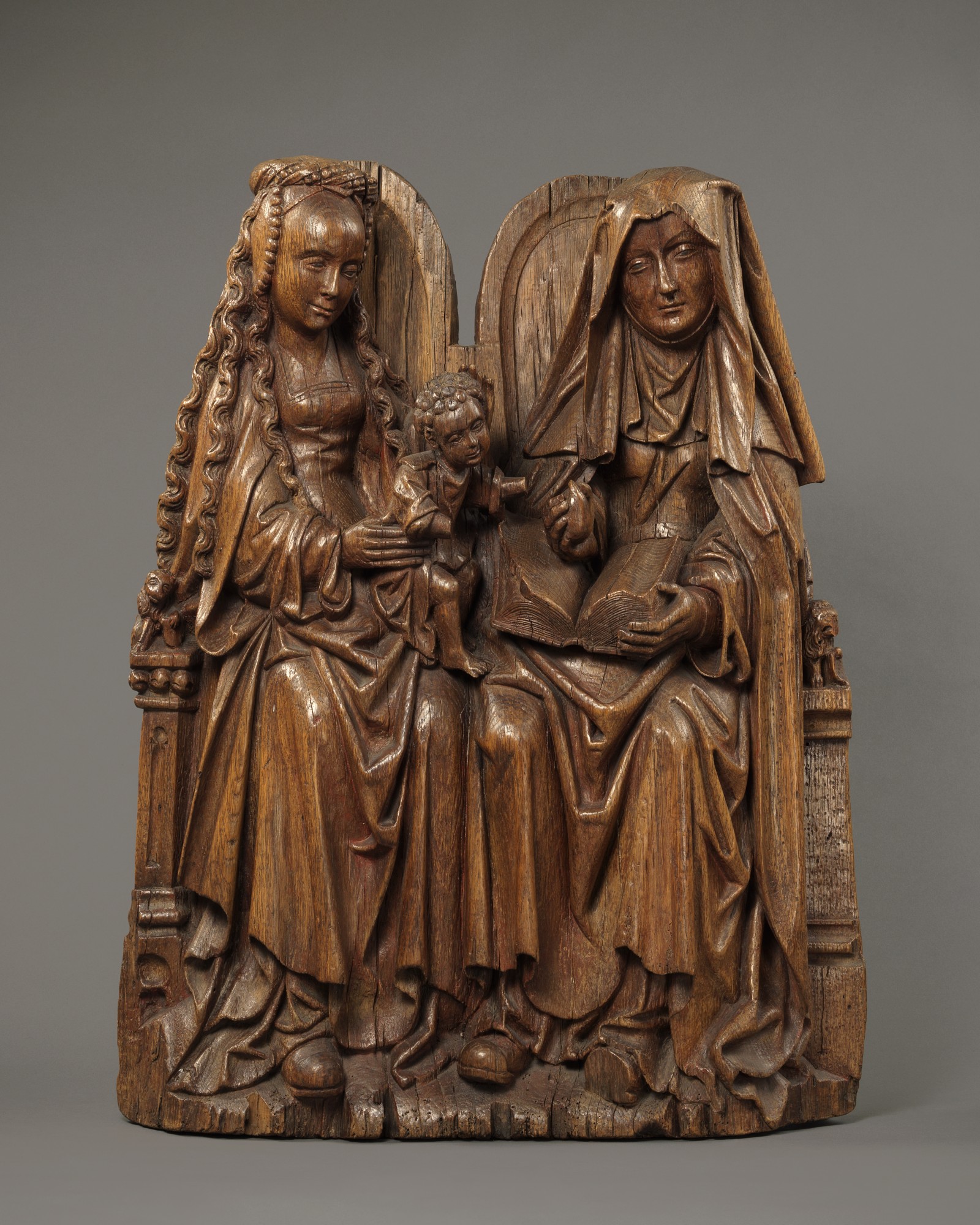


Private collection, Austria
J. W. Steyaert, Late Gothic Sculpture: The Burgundian Netherlands, exhibition catalogue (Museum voor Schone Kunsten, Ghent, 18 September – 27 November 1994) (Ludion Press, Ghent, 1994), pp. 246-247, 253-255, nos. 63, 66
A. Huysmans (ed.), La Sculpture des Pays-Bas méridionaux et de la Principauté de Liège: XVe et XVIe siècles, exhibition catalogue (Musées Royaux d'Art et d'Histoire, Brussels, 15 November 2000) (Musées Royaux d'Art et d'Histoire, Brussels, 2000), no. 14
M. van Vlierden, Hout-en steensculptuur van Museum Catharijneconvent ca. 1200-1600 (Museum Catharijneconvent, Utrecht, 2004), pp. 148, 270-271
In this enchanting group the Virgin balances the standing Christ Child on her knee, he reaching towards his grandmother, Saint Anne, who holds a pear in her right hand, the open gospels resting on her lap. Both daughter and mother are especially beautiful, the Virgin with a delicate face and long ringlets cascading down her shoulders, Saint Anne with a refined elegant poise, her veil framing her older but dignified features. Heads tilted and eyes gazing downwards towards the viewer, the scene is serene.
With her elegant high forehead and elaborate headdress, the Virgin in our group recalls the work of the prominent Brussels sculptor Jan Borreman. The folds of drapery, which outline clearly the knees of the Virgin and Saint Anne, and the round-tipped shoes, may be seen on an Anna Selbdritt now in the Museum Catharijneconvent (Inv. no. ABM bh313, see van Vlierden, op. cit.,) a work also similarly framed by a broad bench with carved sides. In the present sculpture small heraldic lions rest on the tops of the pillars at each end.
Saint Anne is not a biblical figure. She appears first in a second century apocryphal infancy gospel as part of the story of the Saviour’s birth and maternal ancestry. Over the centuries her story circulated throughout eastern and western Christendom but it was not until the late Middle Ages that the cult of Saint Anne became firmly established. Especially popular in German speaking regions from the 14th century, the veneration of Saint Anne as chaste wife, mother and grandmother reached its zenith between 1480 and 1520. She was seen as a figure of devotion among medieval Christians who found solace in her closeness to Jesus and Mary. The increase in her popularity followed extensive promotion of the saint's cult by Netherlandish and Rheinland German humanists and reforming clerics that began in the 1480s in the manifestation of the founding of confraternities dedicated to her and in the writing of lives and other texts. These texts, republished elsewhere in Germany, were of crucial importance in heightening Saint Anne’s popularity for they attributed to her a power unprecedented in saints’ lives – the power to assist in the achievement of salvation. Artists sought to emphasise this power derived from her physical connection to the Redeemer and his mother. The power ascribed to Saint Anne had special appeal for German Christians who, in the 15th century, were showing a heightened concern over individual salvation. The attempt to encourage membership in Saint Anne confraternities was part of a larger clerical program to control and shape lay piety in the late medieval North, in part in response to anxieties over lay, especially lay women's, religious activities, and in part in response to financial pressures.
In the most widely reproduced troupe, known as Anna Selbdritt ('Anne herself the third'), Saint Anne symbolises family life. She is believed to have married three times, having one daughter with each husband. In our beautifully balanced and wonderfully preserved example, both she and the Virgin are cloaked in voluminous robes with exquisitely carved deep folds and traces of the original red polychrome discernible. As is typical, Saint Anne wears the veil of a widow. With the hint of a half-smile, her face is warm and inviting, her gaze tranquil and reassuring. This charming representation of three generations of the Holy Family shows an intimacy and tenderness which is often apparent in this type of iconography.
SOLD: Private collection, France